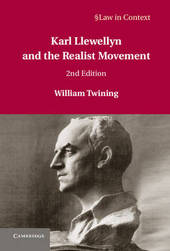
|
Karl Llewellyn and the Realist Movement
Hardback
Main Details
| Title |
Karl Llewellyn and the Realist Movement
|
| Authors and Contributors |
By (author) William Twining
|
| Series | Law in Context |
|---|
| Physical Properties |
| Format:Hardback | | Pages:666 | | Dimensions(mm): Height 229,Width 152 |
|
| ISBN/Barcode |
9781107023383
|
| Classifications | Dewey:340.1092 |
|---|
| Audience | | Professional & Vocational | |
|---|
| Edition |
2nd Revised edition
|
|
Publishing Details |
| Publisher |
Cambridge University Press
|
| Imprint |
Cambridge University Press
|
| Publication Date |
17 September 2012 |
| Publication Country |
United Kingdom
|
Description
First published in 1973, Karl Llewellyn and the Realist Movement is a classic account of American Legal Realism and its leading figure. Karl Llewellyn is the best known and most substantial jurist of the group of lawyers known as the American Realists. He made important contributions to legal theory, legal sociology, commercial law, contract law, civil liberties and legal education. This intellectual biography sets Llewellyn in the broad context of the rise of the American Realist Movement and contains an overview of his life before focusing on his most important works, including The Cheyenne Way, The Bramble Bush, The Common Law Tradition and the Uniform Commercial Code. In this second edition the original text is supplemented with a preface by Frederick Schauer and an afterword in which William Twining gives a fascinating account of the making of the book and comments on developments in relevant legal scholarship over the past forty years.
Author Biography
William Twining is the Quain Professor of Jurisprudence Emeritus at University College London and a regular Visiting Professor at the University of Miami School of Law. He was a pupil of Karl Llewellyn in 1957-8 and put Llewellyn's very extensive papers in order after his death in 1962. Twining's recent writings include Rethinking Evidence, 2nd edition (2006), General Jurisprudence (2009) and How to Do Things with Rules, 5th edition (with David Miers, 2010), all published by Cambridge University Press and recognizable as part of the realist tradition.
Reviews'In offering in the afterword new and important historical data along with crisp and challengeable claims about the nature of legal theory as it is practised today, Twining has combined the historical with the jurisprudential in a way that is both faithful to the original book and that makes the book and its new afterword required reading for all those who wish to understand Karl Llewellyn, Legal Realism, American legal thought, and the nature of law itself.' Fred Schauer, from the Foreword
|